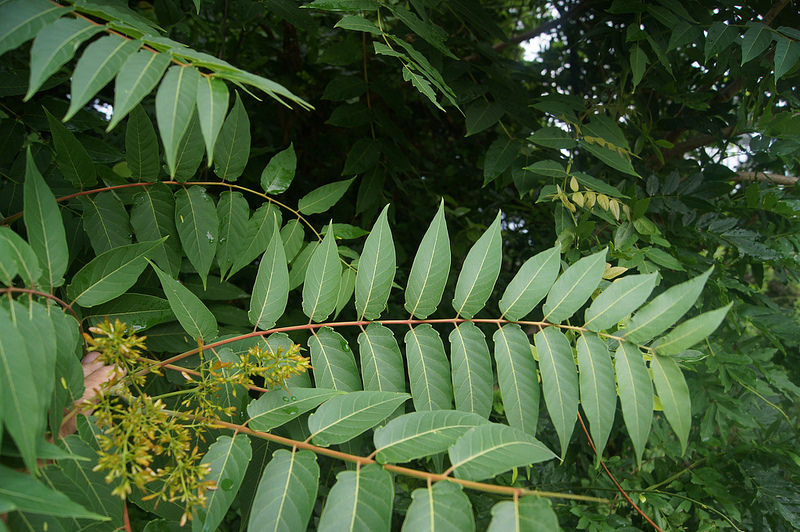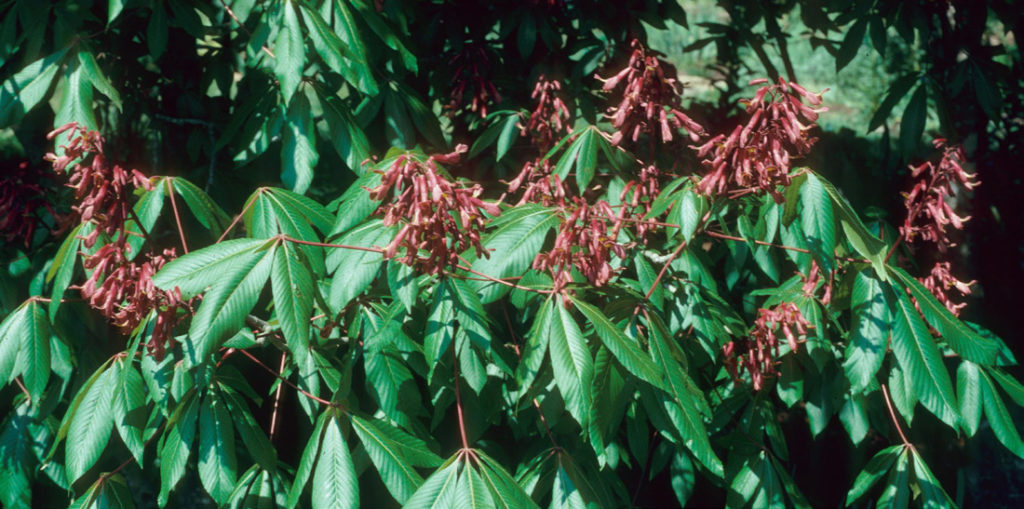Tree of Heaven
Tree of Heaven, commonly known by its scientific name, Ailanthus, and also known as silk tree, is a large, rapidly growing, weak-wooded, deciduous tree that is native to the region spanning from China to Australia.

It was first introduced in the Philadelphia, Pennsylvania, region around the year 1784 and was acclaimed by gardeners as a beautiful specimen tree that quickly rose to popularity as an urban street tree planting. In addition to its aesthetically-pleasing qualities as a street tree, Tree of Heaven is noted for its high tolerance of poor soils and poor air quality. In subsequent years, interest in this tree grew, and it was planted all over the Baltimore and Washington, D.C., areas. Immigrants later introduced Tree of Heaven to the West Coast states during the 1850s. Since then, it has become a significant invasive issue in the urban environments and forests of many states, including Mississippi.
Tree of Heaven establishes very successfully in areas, especially in disturbed sites, and often has a competitive edge over other plants. This is mostly attributed to its remarkable ability to clone itself through root sprouting (suckering) its copious seed production and its tolerance and adaptability to various site and soil conditions.
Identification
Tree of Heaven is an extremely fast-growing tree, capable of growing as much as 49 feet in 25 years, and has the capacity to reach heights of 80 to 100 feet as well as diameters of up to 70 inches. It prefers moist soils; however, this tree is very adaptable to various soil conditions and pH levels and can also thrive in poor soils. It is a bit more finicky with light conditions and will not survive in an environment of heavy shade. The bark of young stems is smooth and green while mature tree bark is light gray and develops a rougher texture with light, tan fissures, similar to the skin of a cantaloupe. Twigs are stout, arranged in an alternate pattern on the tree, and are light brown to greenish in color. Twig centers, or piths, are made up of a spongy material which allows them to break easily. The flowers are formed in large panicles of up to 20 inches long, with individual flowers having five petals and a yellowish-green to reddish color.
Tree of Heaven is dioecious, meaning reproductive structures exist on separate trees, male and female. Clusters of 1- to 2-inch long winged seeds called samaras are produced each year and persist on female trees throughout winter.
Tree of Heaven leaves are bi-pinnately (twice) compound with a smooth edge and numerous leaflets. An individual leaf can bear as many as 40 leaflets. These leaflets are lance-shaped, meaning they are wider toward the middle and taper to a point. The edge (margin) of the leaflets are smooth (entire). When leaves are torn off, prominent leaf scars are unveiled, revealing a heart-shaped or V-shaped scar. Another noteworthy characteristic, the twigs and leaves of Tree of Heaven exude a pungent, offensive odor when crushed.
How It Spreads
Tree of Heaven rapidly colonizes an area by root suckering, a reproductive method that sends suckers from roots to form new plants. This cloning ability gives this species a dominating, competitive edge over many native species. Tree of Heaven commonly threatens urban areas, forest edges, riparian forests along creeks and rivers, roadsides, railways, fence rows as well as forest gaps and disturbed areas. It is known to use allelopathy, a biological suppression technique that emits chemical toxins in the soil to suppress the growth and survival of surrounding trees and plants.
Female trees are prolific seed producers, producing as many as 300,000 seeds per year, which compounds this species’ ability to replicate and spread aggressively. Seeds are extremely light-weight and are adorned with paper-thin wings, allowing easy wind dispersal.
In spite of its advantageous and prolific tendencies, Tree of Heaven tends to be a short-lived species, often surviving less than 50 years.
Management
To help prevent the spread, do not plant Tree of Heaven. Instead, select native alternatives, such as red buckeye (Aesculus pavia), musclewood (Carpinus caroliniana), Carolina silverbell (Halesia carolina), American holly (Ilex opaca), sassafras (Sassafras albidum) or Southern sugar maple (Acer floridanum or A. barbatum).
Tree of Heaven is very difficult to control, especially due to its aggressive re-sprouting ability, rapid growth and extensive root system. The key to controlling Tree of Heaven is controlling the root system. Hand pulling seedlings during moist soil conditions is effective as long as the entire root system is extracted. Any root fragments left behind in the soil are capable of quickly generating new plants.
For control along roadsides, existing stems must be cut first and mowed regularly to prevent re-establishment. Regrowth from an established root system will be fast and furious, but new seedlings will be soft-wooded and can be mowed easily. It could take several years to completely deplete a firmly-established root system. One missed mowing cycle can allow sprouts to become too big to mow and successful control more challenging.
Several herbicides provide effective chemical control against Tree of Heaven, such as Triclopyr and Imazapyr, branded as Garlon 3A and Arsenol, respectively, among others. These herbicides are applied to leaves (foliar), stems and cut surfaces. For best results, apply herbicides during the growing season, between summer and fall. Foliar sprays are usually most effective and produce the best results. Basal bark sprays chemically girdle stems and are also effective when applied during the growing season to selected stems. However, basal bark sprays can be quite labor-intensive, especially when treating areas where Tree of Heaven is well-established with a high number of stems.
Cut surface treatments are also an effective treatment method but are also considered to be quite laborious when treating in areas of dense populations.
In general, successful control will require repeated steps and ongoing maintenance to prevent re-establishing in an area.
Alternatives
Instead of planting Tree of Heaven, Ailanthus, plant native Scarlet Buckeye, Aesculus Pavia. This small tree grows best in partial shade. Hummingbirds and bees visit the flowers, and the nuts are spread by squirrels.

(Photo by John Ruter, University of Georgia, Bugwood.org)
Contact MFC for more information
For more information about Japanese climbing fern in Mississippi, contact us at comments@mfc.ms.gov.
